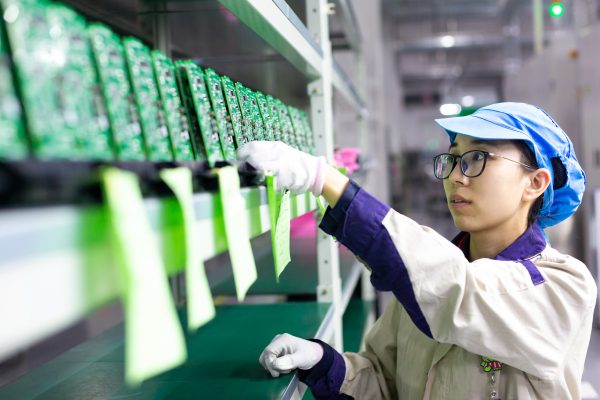China’s manufacturing purchasing managers index (PMI) fell from 50 in January to 35.7 in February. A number below 50 signals a contraction and it had never fallen so low since the index was inaugurated in 2004.
The inability to secure imports of personal protective equipment and medical supplies from China in those early months of the pandemic exacerbated the health panic many countries faced. Governments raced to find solutions and many are now deploying policies to ensure those sorts of disruptions don’t occur again, both in essential healthcare and in manufacturing more broadly.
Japan, and later South Korea, introduced subsidies to onshore manufacturing and to expand supply chains in Southeast Asia. Those subsidies have become known as China-exit subsidies although Japan has been careful not to officially name China as their target. Japan’s subsidies of US$2 billion to onshore manufacturing and $US200 million to expand supply chains to Southeast Asia (and now South Asia) are over-subscribed.
Other countries are contemplating various measures to achieve supply chain diversification (away from China).
But just how vulnerable are supply chains and what should governments be doing to reduce supply chain risk? Were the many companies that relied on complex supply chains that cross numerous borders and jurisdictions ignorant of the risks? Did they collectively put all their eggs in the one China basket, thereby creating systemic risk?
Governments need to be clear on what the problems that they are trying to fix before they start intervening with subsidies and other regulations.
It’s important to recognise what businesses want and how resilient the supply chains have been.
In this week’s lead essay John Denton and Damien Bruckard from the International Chamber of Commerce argue that ‘“supply chain fragility” has been disingenuously invoked or hyped-up to cover for governmental failures. Inadequate stockpiles of masks, medicines and ventilators cannot reasonably be described as failures of corporate supply chains — they were failures of government planning’.
It’s not clear that supply chains were vulnerable nor that they now need reinvention. Resilience is the ability to bounce back and the evidence points to remarkable supply chain resilience in the face of a once-in-a-lifetime crisis.
The market worked and businesses responded to supply shortages. ‘Alcohol companies produced hand sanitiser, textiles manufacturers made masks and hotels become quarantine centres’, Denton and Bruckard explain. ‘Delivery services ensured door-to-door supply of essential goods such as medical equipment, medicine and food at the height of the crisis’. That this was achieved ‘during the greatest economic shock in a century suggests more robustness than fragility’, they argue.
China’s PMI rebounded to 52.0 by March from its low of 35.7 in February as much of the rest of the world went into lockdown to fight the spread of the pandemic. It is now at a decade high of 53.1.
Supply chains have contributed to the rapid expansion of production at lower cost, with companies able to achieve fragmented, task-based specialisation in the name of just-in-time production. That has enabled more small and medium-sized companies and their workers to join international production networks. Requiring companies to hold reserves of inventory for just-in-case delivery is throwing sand in the gears of efficient global manufacturing.
Forces of comparative advantage and specialisation that fragment production across different locations and forces of agglomeration and economies of scale that concentrate them help to shape supply chains. Businesses diversify as a form of insurance and there’s a cost to that. They weigh and manage risk and their viability and profitability depend on making the right decisions.
Poor policy prescriptions threaten business dynamism and investment and the world is going to need both to recover from the COVID-19 crisis and reduce unemployment.
Denton and Bruckard warn that ‘nativist policies aimed at concentrating industries in one place — “reshoring” or “regionalising” supply chains — will likely undercut competitiveness, raise consumer prices and render entire industries more vulnerable to smaller, localised and more frequent shocks like floods, blackouts or social upheaval’. Many companies may choose to shorten supply chains but governments should be careful about implementing policies that encourage that as it concentrates risk.
Many Japanese multinationals have been reorganising their supply chains in Asia regardless of the ‘China-exit’ subsidy. Japanese companies have been restructuring their supply chains in Asia and investments over time due to rising labour costs in China. The ‘China plus one’ strategy of diversifying investment has been common practice for years. The subsidies may distort decisions and concentrate risk, or simply be a form of corporate welfare or privileging.
Comprehensive supply chain resilience requires a multilayered approach. To reduce supply chain vulnerability governments must commit to avoiding tariffs and export controls — ensuring free trade in goods and services — and facilitate the digital infrastructure that helps manage supply chain risk. Openness to foreign direct investment will help businesses diversify risk. Developing digital infrastructure and creating international regulatory coherence in digital trade protocols will enhance visibility across supply chains beyond immediate tier-one suppliers and help identify vulnerabilities. Regional data privacy standards, tax and other incentives to share data will encourage the use of digital supply networks.
That’s a much bigger and more complex policy agenda than subsidies or inventory requirements that requires cooperation between countries. The reality is supply chains will continue to go through China and cross multiple borders — the job of government policy is to help improve the infrastructure for those operations between countries and to improve the broader business environment.
The EAF Editorial Board is located in the Crawford School of Public Policy, College of Asia and the Pacific, The Australian National University.

